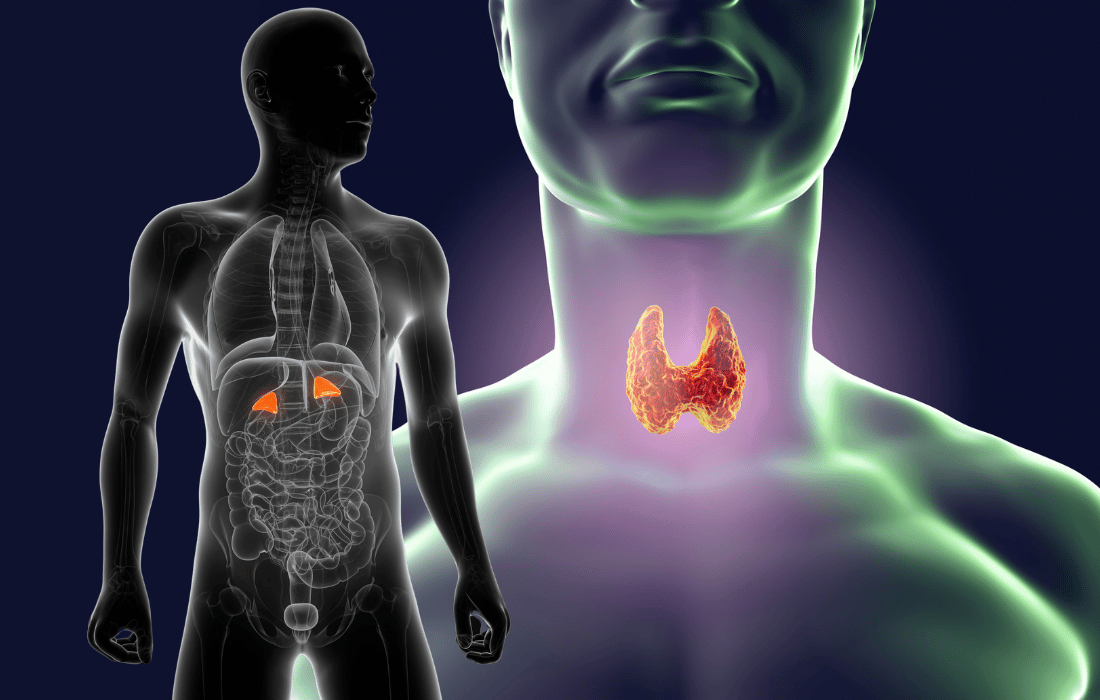Now, it’s important to acknowledge up front that completely avoiding these toxins is unrealistic. We live in a world filled with synthetic chemicals, industrial materials, and artificial lights. No matter how diligent, athletes can’t eliminate every single source of endocrine disruption from their lives. But that doesn’t mean we should throw up our hands in defeat. Small, intentional lifestyle adjustments can significantly reduce exposure over time, building resilience and giving athletes a critical edge. Here’s a look at how these silent disruptors enter an athlete’s routine, what effects they have on the body, and practical ways to minimize exposure.
What Are Endocrine Disruptors, and Why Do They Matter?
Endocrine disruptors are chemicals that interfere with the endocrine system, the network of glands that produce hormones responsible for regulating metabolism, energy, mood, muscle growth, and more. For athletes, who depend on finely tuned hormonal balance to perform at their best, this interference can be a game-changer. Hormones like testosterone, cortisol, and growth hormone are critical for recovery, strength, endurance, and mental resilience. When endocrine disruptors mimic, block, or alter these hormones, they throw the body off balance and may lead to compromised athletic performance.
Even if these disruptors don’t cause immediate, noticeable effects, their impact accumulates over time, creating a toxic load that can erode performance and health in the long run. Understanding where these toxins come from—and adopting lifestyle changes to minimize exposure—is essential for athletes seeking to protect their bodies and sustain peak performance.
Common Endocrine Disruptors Lurking in an Athlete’s Environment
Environmental toxins often go unnoticed because they’re embedded in so many aspects of daily life. From the gym to the home, these disruptors find their way into athletes’ routines in sneaky ways. Here’s a breakdown of some of the most pervasive sources of endocrine disruptors and actionable steps athletes can take to reduce their impact.
1. Plastic Products in Athletic Gear and Accessories
The Threat: Plastic items aren’t just problematic because of chemicals like bisphenol-A (BPA) and phthalates; they also release microplastics—tiny plastic particles that break down from larger plastic items. These microplastics are now found in everything from the air we breathe to the water we drink and can accumulate in the body over time. Microplastics often contain hormone-disrupting chemicals that mimic estrogen and interfere with testosterone and other critical hormones, potentially leading to increased body fat, muscle loss, and reproductive health issues. Studies have linked both BPA and microplastic exposure to hormonal imbalances, reduced sperm quality, and impaired muscle growth, all of which can hinder athletic performance.
Common Sources: Plastic water bottles, protein shakers, synthetic gym clothes, exercise mats, and gym flooring are primary sources. Synthetic fabrics like polyester shed microplastics when washed, which can then enter our water systems and food chain. Microplastics have even been found in bottled water, creating a feedback loop that continuously reintroduces them to the body.
Safer Alternatives: Choose glass water bottles and food containers to avoid plastic leaching. Stainless steel is safer than plastic water bottles, but can eventually begin leeching dangerous heavy metals. Opt for natural fibers such as organic cotton, hemp, or wool when selecting athletic wear, as these don’t shed microplastics. Though synthetic fabrics are common in athletic gear, some companies are now creating health-conscious options that prioritize athlete well-being. By swapping out high-exposure plastic items, athletes can reduce their intake of both BPA and microplastics, supporting healthier hormone balance and long-term performance.
2. Processed Foods and Artificial Ingredients
The Threat: Processed foods and some sports supplements contain additives, preservatives, and artificial ingredients, which can disrupt hormone balance and impair recovery. Additives like butylated hydroxyanisole (BHA) and butylated hydroxytoluene (BHT) act as preservatives but also have estrogenic effects, interfering with thyroid function and potentially causing weight gain, fatigue, and metabolic issues. Artificial sweeteners, like aspartame, may also affect hormone regulation, particularly insulin and cortisol levels.
Common Sources: Energy bars, protein powders, sports drinks, and flavored recovery shakes often contain these disruptive ingredients, even if they market themselves as “natural” or “clean.”
Safer Alternatives: Prioritize whole foods over processed options whenever possible (JERF: Just Eat Real Food). Choose simple, minimally processed supplements with clear, natural ingredients (beware of “natural flavors” that don’t disclose what those flavors are), and avoid products with artificial colors, flavors, and sweeteners. Look for third-party certifications that verify the purity of supplements, ensuring they’re free of harmful additives.
3. Contaminants in Water: Drinking and Showering
The Threat: Hydration is critical for athletic performance, but the quality of that water matters. Tap water often contains contaminants like fluoride, chlorine, and pesticide residues that disrupt endocrine function, particularly the thyroid. Since the thyroid plays a significant role in regulating metabolism, poor thyroid health can lead to decreased energy, slowed recovery, and increased fat storage. Over time, even low levels of these contaminants can accumulate and have a greater effect on hormonal health.
Common Sources: Most urban tap water contains these chemicals, and while bottled water might seem like an alternative, it’s often just filtered tap water and sometimes stored in plastic, leading to BPA leaching.

Safer Alternatives: Invest in a high-quality water purification system for drinking and cooking. A reverse osmosis system or countertop purifier, like AquaTru, effectively removes contaminants like fluoride, chlorine, and other residues. Athletes should also consider installing a shower filter since skin, the body’s largest organ, absorbs contaminants from shower water. Reducing exposure in both drinking and shower water can significantly cut down on the body’s toxin load.
4. Personal Care Products, Synthetic Fragrances, and Household Cleaners
The Threat: Personal care products, synthetic fragrances, and household cleaners are common sources of endocrine-disrupting chemicals and airborne pathogens like parabens, phthalates, and volatile organic compounds (VOCs). Parabens are preservatives that mimic estrogen and are linked to reduced testosterone levels and reproductive issues. Phthalates, often used to stabilize fragrances, can interfere with hormone regulation, affecting muscle growth, mood, and energy levels. VOCs, frequently found in household cleaners, air fresheners, and scented candles, can increase oxidative stress, disrupt respiratory health, and impair hormonal balance, especially when regularly inhaled in enclosed spaces.
Common Sources: Shampoos, lotions, deodorants, sunscreens, cleaning sprays, laundry detergents, air fresheners, and scented candles are frequent culprits. Many personal care products are used daily by athletes, creating constant exposure. Even “green” or “natural” household products can contain hidden endocrine disruptors under the vague label of “fragrance.”

Safer Alternatives: Choose organic, fragrance-free personal care products, or those scented with essential oils (keeping in mind that some essential oils, like lavender, can have negative hormonal effects if used in excess). For household cleaning, opt for unscented or natural products, or consider simple DIY solutions like vinegar, baking soda, and essential oils. If you enjoy a pleasant-smelling home, use essential oil diffusers sparingly, and consider an air purifier, like the AirDoctor, to help remove airborne chemicals. Prioritizing products with minimal and natural ingredients can reduce exposure to hormone disruptors, protecting long-term health and performance.
5. Electromagnetic Fields (EMF)
The Threat: Electromagnetic fields (EMFs) are invisible energy waves emitted by electronic devices, Wi-Fi routers, cell phones, and many other modern technologies. Emerging research links chronic EMF exposure to oxidative stress, inflammation, and even hormone disruption, particularly affecting cortisol, melatonin, and testosterone levels. Oxidative stress induced by EMF exposure can impair cellular function and recovery, making it particularly relevant for athletes who rely on optimal cell health for endurance and muscle repair. EMFs can also interfere with sleep quality by disrupting melatonin production, which is essential for recovery and immune function.
Common Sources: Athletes encounter EMFs almost everywhere—gyms filled with electronics, stadiums with high-powered lighting, wearable tech devices like fitness trackers, and even personal items like cell phones and wireless headphones. Since athletes can’t easily avoid these EMF sources in training or competition settings, their bodies can face cumulative exposure that potentially affects long-term performance and health.

Safer Alternatives: Although it’s impossible to avoid EMFs entirely, especially in our tech-dependent world, there are ways to minimize exposure, particularly during rest and recovery times. Consider using EMF-reducing devices such as Aires Tech’s EMF protection tools, which help shield the body from excessive EMF exposure.
Athletes can also reduce EMF exposure by switching off Wi-Fi at night, keeping phones in airplane mode or using wired headphones instead of Bluetooth, and minimizing screen time close to bedtime to support natural melatonin production. Grounding practices, such as walking barefoot on grass or using grounding mats, may also help reduce EMF-induced oxidative stress by discharging excess positive ions from the body.
6. Artificial Lighting and Blue Light
The Threat: Exposure to artificial light from LED lighting and screens has become ubiquitous, and it’s particularly problematic for athletes due to its effect on circadian rhythms. Blue light suppresses melatonin, the hormone that regulates sleep and recovery, leading to poor sleep quality and affecting cortisol and growth hormone production.
Common Sources: Gyms, stadiums, phones, tablets, and computers all emit blue light. Athletes may find themselves surrounded by artificial lighting during training, competition, or even at home, especially in the evening when blue light is most disruptive.

Safer Alternatives: Switch to incandescent bulbs at home for warmer lighting, which has less impact on melatonin. In the evening, consider wearing blue-light-blocking glasses like Ra Optics to reduce exposure from screens. Since athletes can’t always control their lighting environment in gyms or stadiums, using these strategies at home can help protect sleep quality and hormone balance, building resilience for those times when blue light exposure is unavoidable.
The Real Challenge: Total Avoidance Isn’t Practical, But Small Changes Matter
While making these lifestyle adjustments can significantly reduce exposure to endocrine disruptors, it’s important to remember that complete avoidance is nearly impossible in today’s world. Athletes can’t expect stadiums to replace LED lights with incandescent bulbs, nor can they control what type of flooring or cleaning products are used at the gym. Many athletic wear brands rely on synthetic materials like polyester, and it’s often not feasible to replace every plastic item in daily life.
But this reality shouldn’t lead to defeat. The goal is not to eliminate every toxin but to reduce exposure where possible. Small, consistent changes—like switching to filtered water, using natural personal care products, and investing in blue-light-blocking glasses—add up over time. These adjustments create a foundation of resilience, allowing athletes to handle unavoidable exposures without their bodies being overwhelmed.
Final Thoughts: Building Long-Term Health in a Toxin-Filled World
Environmental toxins and endocrine disruptors are an unfortunate reality of modern life, but with awareness and intentional choices, athletes can protect themselves. By taking small steps—opting for cleaner food, safer products, filtered water, and more sleep-conscious lighting—they build a strong foundation for resilience. This approach isn’t about perfection or eliminating every toxin; it’s about prioritizing health in the face of unavoidable exposure.
With each thoughtful choice, athletes reduce their overall toxic load, building resilience and safeguarding performance. In the end, caring about environmental toxins isn’t just a health choice; it’s an investment in long-term success, energy, and vitality. Athletes push boundaries every day, and this invisible challenge is no different—it’s a call to not just train hard, but to protect the body for a lifetime of peak performance.







